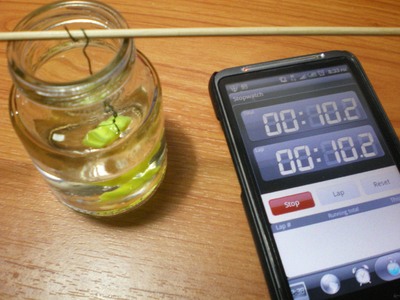We’ve written previously about a method to create a perfectly smooth (even shiny) surface finish on your ABS plastic 3D prints, but one wonders whether the same can be done on PLA 3D prints.
ABS plastic is dissolved by Acetone, so a typical approach is to (CAREFULLY AND SAFELY) dip your ABS object into an Acetone vapor to soften and smooth its exterior surface. PLA is a biodegradable material that can actually be dissolved in water if you wait long enough – but what happens when you mix it with Acetone?
The folks at Funbie studios decided to give this a shot and performed the experiment. They organized a glass jar containing a healthy amount of Acetone and submerged several printed PLA objects using wire suspension.
The results? Not good. As you can see, several of the objects actually starting losing their color almost instantly.
We’re wondering if the test should be repeated using Acetone vapor instead of Acetone submersion? The vapor would deposit far less Acetone at a much slower rate, permitting more control over the affect on the object.
Via Funbie Studios




Hey, thanks for the repost of our little experiment. And yes, acetone doesn't work well at all for PLA, though we are saving it up for when we do get an ABS 3D Printer.
Acetone vapour wasn't something we've tried given that it seems not to be the correct solvent to start with. Even a dip in that stuff caused white flaky stuff to form on the PLA, so this technique is out of the window for us.
Something else we've see being recommended and tried out is NaOH but we haven't had much luck with that either. It could be a problem of the concentration but we haven't completely tested that out.
Other options are perhaps controlled heat/steam … Maybe stuff for a future tests which we will post about 😉
Hey, thanks for the repost of our little experiment. And yes, acetone doesn't work well at all for PLA, though we are saving it up for when we do get an ABS 3D Printer.
Acetone vapour wasn't something we've tried given that it seems not to be the correct solvent to start with. Even a dip in that stuff caused white flaky stuff to form on the PLA, so this technique is out of the window for us.
Something else we've see being recommended and tried out is NaOH but we haven't had much luck with that either. It could be a problem of the concentration but we haven't completely tested that out.
Other options are perhaps controlled heat/steam … Maybe stuff for a future tests which we will post about 😉
Weird.. it's almost like it's crazing the plastic. Slightly miss leading title! So far the only ABS plastics to have lost pigment during acetone vapour smoothing (in my tests) were thermochromatic filaments like the ones sold by 3d printing systems… The acetone denatures them into a really bland pastel colour. Has anyone tried like… just steam?
Weird.. it's almost like it's crazing the plastic. Slightly miss leading title! So far the only ABS plastics to have lost pigment during acetone vapour smoothing (in my tests) were thermochromatic filaments like the ones sold by 3d printing systems… The acetone denatures them into a really bland pastel colour. Has anyone tried like… just steam?